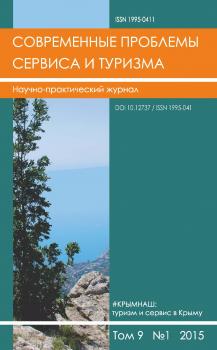Moscow, Russian Federation
from 01.01.2017 to 04.02.2017
Moskva, Moscow, Russian Federation
The article is devoted to the storytelling as a relatively new marketing technology for tourist destinations. Tourism storytelling is defined as an integrated marketing technology for promoting tourism destinations through narrative information: legends, myths, fables, urban stories and tales. Tourism narrative become a self-contained attractor, supplementing or even replacing traditional objects of tourist interest. It can be realized through a variety tourist consumption tools. The most important among them are material products (souvenirs, travel guides, etc.), figurative-symbolic objects (street art, iconographic documents, multimedia formats), verbal means, online resources, etc. The authors offer the concept of a “storytelling destination” as an attractive object for tourists, in the marketing promotion of which the technology of storytelling prevails. The article defines the city storytelling tourism place and describes the phenomenon of post-travel storytelling. The authors also accomplish a detailed review of foreign publications on the problems of storytelling and its role in the tourist destinations development, consider some cases of the world’s and Russian storytelling destinations and separate mechanisms for their operating (cases of Kaliningrad, Borovsk, St. Petersburg, etc.). The article characterizes the tourism storytelling as a marketing technology, its and some tools. It is determined that finding out or creating legends and their using in the marketing tourism places is one of the most common technologies of tourism storytelling. The authors present the classification of technologies of storytelling and legend in active tourism.
storytelling, tourism storytelling, using legends in tourism, storytelling destination, tourism technologies, marketing technology, post-travel storytelling, storytelling in active tourism.
1. Afanas'ev O.E. O nekotoryh aspektah ispol'zovaniya istoriograficheskogo podhoda v uchebnom kurse «Tehnologii v'ezdnogo turizma» // Vestnik Associacii vuzov turizma i servisa. 2016. T.10. №2. S. 12-18. DOI:https://doi.org/10.12737/19542.
2. Afanas'ev O.E. Kartografiya i toponimika: metodologiya regional'nogo pohoda k izucheniyu // Pskovskiy regionologicheskiy zhurnal. 2007. №4. S. 99-110.
3. Afanas'ev O.E., Afanas'eva A.V. Muzei legend v sovremennom turistskom prostranstve // Sovremennye problemy servisa i turizma. 2016. T.10. №2. S. 38-46. DOI:https://doi.org/10.12737/19502.
4. Afanas'ev O.E., Afanas'eva A.V. Funkcional'noe znachenie i mesto turistskih legend v formirovanii privlekatel'nyh svoystv destinaciy // Vestnik Associacii vuzov turizma i servi- sa. 2015. T.9. №1. S. 52-60. DOI:https://doi.org/10.12737/7943.
5. Afanas'ev O.E., Trocenko A.V. Kategoriya «legenda» v regional'nom toponimicheskom pro- stranstve (na primere Dnepropetrovskoy oblasti Ukrainy) // Pskovskiy regionologicheskiy zhurnal. 2014. №17. S. 67-77.
6. Afanasiev O.E., Afanasieva A.V. Museums of Dark Mythologies in the Tourist Place. In: Virtual traumascapes and exploring the roots of dark tourism. Ed. by: M. Korstanje, B. George. Hershey: IGI Global, 2017. Ch.2. Pp. 26-49. DOI:https://doi.org/10.4018/978-1-5225-2750-3.ch002.
7. Alasuutari P. The discursive construction of personality. In A. Lieblich & R. Josselson (Eds.), Narrative study of lives. Thousand Oaks, CA: Sage, 1997. Vol. 5. Pp. 1-20.
8. Armstrong D.G. Managing by Storying Around: A New Method of Leadership. N.Y.: Doubleday, 1992.
9. Arnould E., Price L. River Magic: Extraordinary Experience and the Extended Service Encounter // Journal of Consumer Research. 1993. Vol.20. Pp. 24-45. DOI:https://doi.org/10.1086/209331.
10. Barry D., Elmes M. Strategy retold: Toward a narrative view of strategic discourse // Academy of Man- agement Review. 1997. Vol. 22. Iss.2. Pp. 429-452. DOI:https://doi.org/10.2307/259329.
11. Boje D.M. The storytelling organization: A study of story performance in an office-supply firm // Ad- ministrative Science Quarterly. 1991. Vol. 36. Iss.1. Pp. 106-126. DOI:https://doi.org/10.2307/2393432.
12. Boyce M.E. Organizational story and storytelling: A critical review // Journal of Organizational Change. 1996. Vol.9. Iss.5. Pp. 5-26. DOI:https://doi.org/10.1108/09534819610128760.
13. Bruner J. Actual Minds, Possible Worlds. Cambridge: Harvard University Press, 1986.
14. Bruner J. Life as Narrative // Social Research. 1987. Vol. 54. No.1. Pp. 11-32.
15. Bruner J.S. Acts of meaning. Cambridge, MA: Harvard University Press, 1990.
16. Campbell J. The Hero with a Thousand Faces. Bollingen Series. Princeton University Press, 1973.
17. Chronis A. Coconstructing heritage at the Gettysburg storyscape // Annals of Tourism Research. 2005. Vol.32. Iss.2. Pp. 386-406. DOI:https://doi.org/10.1016/j.annals.2004.07.009.
18. Chronis A. Tourists as Story-Builders: Narrative Construction at a Heritage Museum // Journal of Travel & Tourism Marketing. 2012. Vol.29. No.5. Pp. 444-459. DOI:https://doi.org/10.1080/10548408.2012.691395.
19. Deighton J. The consumption of performance // Journal of Consumer Research. 1992. Vol.19. No.3. Pp. 362-372. DOI:https://doi.org/10.1086/209307.
20. Deighton J., Romer D., McQueen J. Using drama to persuade // Journal of Consumer Research. 1989. Vol.16. No.3. Pp. 335-343. DOI:https://doi.org/10.1086/209219.
21. Denning S. Effective storytelling: strategic business narrative techniques // Strategy & Leadership. 2006. Vol.34. No.1. Pp. 42-48. DOI:https://doi.org/10.1108/10878570610637885.
22. Denning S. The Springboard - How Storytelling Ignites Action in Knowledge-Era Organizations. Woburn: Butterworth-Heinemann, 2001.
23. Escalas J.E. The positive effects of narrative thought in response to advertising // Advances in Con- sumer Research. 1997. Vol.24. Pp. 67-68.
24. Escalas J.E. Advertising narratives: What are they and how do they work? In B. Stern (Ed.), Represent- ing consumers: Voices, views, and visions. N.Y.: Routledge, 1998. Pp. 267-289.
25. Escalas E.J. Narrative processing: Building consumer connection to brands // Journal of Consumer Psychology. 2004. Vol.14. Iss.1-2. Pp. 168-180. DOI:https://doi.org/10.1207/s15327663jcp1401&2_19.
26. Fisher W. Narration as a Human Communication Paradigm: The Case of Public Argument. Communica- tion Monographs. 1984. Vol. 51. Pp. 1-22. DOI:https://doi.org/10.1080/03637758409390180.
27. Fog K., Budtz S., Yakaboylu V. Storytelling: Branding in Practice. S.I.: Springer, 2006. 238 p.
28. Grayson K. Stories and Selling: The Narrative Strategies of Direct Sales Agents // Advances in Consumer Research. 1997. Vol. 24. Iss. 68. Pp. 67-70.
29. Gubrium J.F., Holstein J.A. Narrative Practice and the Coherence of Personal Stories // The Sociological Quarterly. 1997. Vol.39. No.1. Pp. 163-187. DOI:https://doi.org/10.1111/j.1533-8525.1997.tb02008.x.
30. Heath C., Heath D. Made to stick: why some ideas survive and others die. N.Y.: Random House, 2010.
31. Herbert D. Literary Places, Tourism and the Heritage Experience // Annals of Tourism Research. 2001. Vol.28. Iss.2. Pp. 312-333. DOI:https://doi.org/10.1016/s0160-7383(00)00048-7.
32. Johnston B. Stories, Community, and Place: Narratives from Middle America. Bloomington: Indiana University Press, 1990.
33. Korstanje M.E. What is tourism? An anthropocentric discussion // Covremennye problemy servisa i turizma. 2016. T.10. №2. S. 7-18. DOI:https://doi.org/10.12737/19498.
34. Levy S.J. The consumption of stories. Atlanta, GA: Association of Consumer Research, 2002.
35. Mattila A.S. The Role of Narratives in the Advertising of Experiential Services // Journal of Services Research. 2000. Vol.3. No.1. Pp. 35-45. DOI:https://doi.org/10.1177/109467050031003.
36. Mossberg L., Johansen E.N. Storytelling - Marknadsföring i upplevelseindustrin. Lund: Studentlitteratur, 2006.
37. Mossberg L. Extraordinary Experiences through Storytelling // Scandinavian Journal of Hospitality and Tourism. 2008. Vol.8. No.3. Pp. 195-210. DOI:https://doi.org/10.1080/15022250802532443.
38. Gergen K.J., Gergen M.M. Narrative and the self as relationship // Advances in Experimental Social Psychology. 1988. Vol.21. Pp. 17-56. DOI:https://doi.org/10.1016/S0065-2601(08)60223-3.
39. Rickly-Boyd J. The tourist narrative // Tourist Studies. 2010. Vol.9. No.3. Pp. 259-280. DOI:https://doi.org/10.1177/1468797610382701.
40. Salzer-Mörling M., Strannegård L. Silence of the brands // European Journal of Marketing. 2004. Vol.38. No.1/2. Pp. 224-238. DOI:https://doi.org/10.1108/03090560410511203.
41. Shankar A., Elliott R., Goulding C. Understanding Consumption: Contributions from a Narra- tive Perspective // Journal of Marketing Management. 2001. Vol.17. Iss. 3-4. Pp. 429-453. DOI:https://doi.org/10.1362/0267257012652096.
42. Simmons A. The Story Factor: Secrets of Influence from the Storytelling. N.Y.: Basic Books, 2009.
43. Stern B. Consumer myths: Frye’s taxonomy and the structural analysis of consumption text // Journal of Consumer Research. 1995. Vol.22. No.2. Pp. 165-185. DOI:https://doi.org/10.1086/209443.
44. Stokowski P.A. Languages of place and discourses of power: Constructing new senses of place // Journal of Leisure Research. 2002. Vol.34. Pp. 368-382. DOI:https://doi.org/10.1086/209443.
45. Tuan Y.-F. Language and the making of place: A narrative-descriptive approach // Annals of the As- sociation of American Geographers. 1991. Vol.81. No.4. Pp. 684-696. DOI:https://doi.org/10.1111/j.1467-8306.1991. tb01715.x.
46. Twitchell J.B. An English teacher looks at branding // Journal of Consumer Research. 2004. Vol.31. Iss.2. Pp. 484-489. DOI:https://doi.org/10.1086/422125.
47. Vogler C. The Writer’s Journey. London: Pan Books, 2004.
48. Woodside A.G., Megehee C.M. Travel Storytelling Theory and Practice // Anatolia: An International Journal of Tourism and Hospitality Research. 2009. Vol. 20. No.1. Pp. 86-99. DOI:https://doi.org/10.1080/13032917.2009.10518897.





